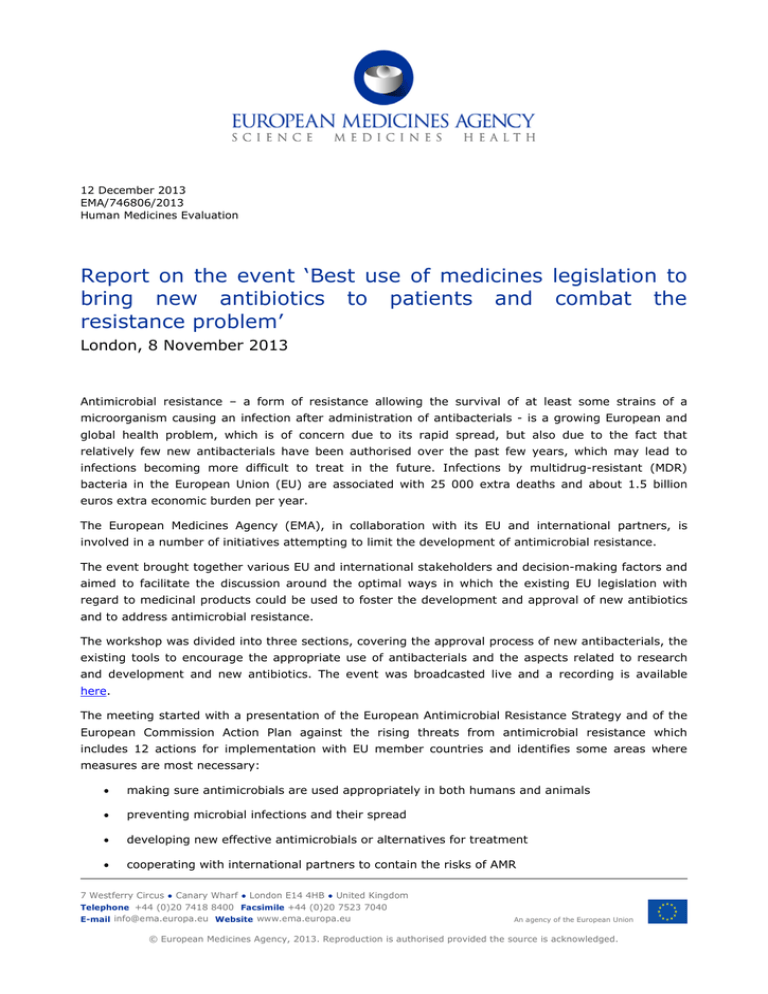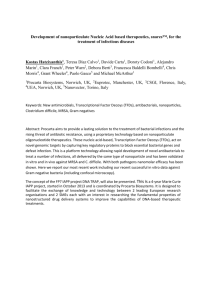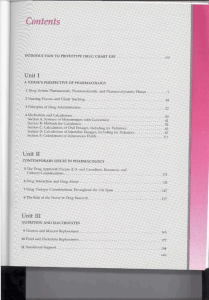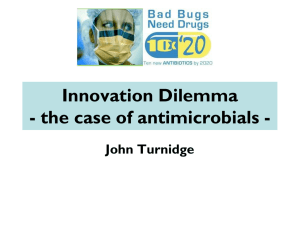Report on the event ‘Best use of medicines legislation to
advertisement

12 December 2013 EMA/746806/2013 Human Medicines Evaluation Report on the event ‘Best use of medicines legislation to bring new antibiotics to patients and combat the resistance problem’ London, 8 November 2013 Antimicrobial resistance – a form of resistance allowing the survival of at least some strains of a microorganism causing an infection after administration of antibacterials - is a growing European and global health problem, which is of concern due to its rapid spread, but also due to the fact that relatively few new antibacterials have been authorised over the past few years, which may lead to infections becoming more difficult to treat in the future. Infections by multidrug-resistant (MDR) bacteria in the European Union (EU) are associated with 25 000 extra deaths and about 1.5 billion euros extra economic burden per year. The European Medicines Agency (EMA), in collaboration with its EU and international partners, is involved in a number of initiatives attempting to limit the development of antimicrobial resistance. The event brought together various EU and international stakeholders and decision-making factors and aimed to facilitate the discussion around the optimal ways in which the existing EU legislation with regard to medicinal products could be used to foster the development and approval of new antibiotics and to address antimicrobial resistance. The workshop was divided into three sections, covering the approval process of new antibacterials, the existing tools to encourage the appropriate use of antibacterials and the aspects related to research and development and new antibiotics. The event was broadcasted live and a recording is available here. The meeting started with a presentation of the European Antimicrobial Resistance Strategy and of the European Commission Action Plan against the rising threats from antimicrobial resistance which includes 12 actions for implementation with EU member countries and identifies some areas where measures are most necessary: • making sure antimicrobials are used appropriately in both humans and animals • preventing microbial infections and their spread • developing new effective antimicrobials or alternatives for treatment • cooperating with international partners to contain the risks of AMR 7 Westferry Circus ● Canary Wharf ● London E14 4HB ● United Kingdom Telephone +44 (0)20 7418 8400 Facsimile +44 (0)20 7523 7040 E-mail info@ema.europa.eu Website www.ema.europa.eu An agency of the European Union © European Medicines Agency, 2013. Reproduction is authorised provided the source is acknowledged. • improving monitoring and surveillance in human and animal medicine • promoting research and innovation • improving communication, education and training. The structure of the event aimed to foster the discussion between the various stakeholders about the most appropriate actions which could be envisaged and to present the results of some already completed initiatives targeting antimicrobial resistance. Section 1 Approval of new antibacterials It is currently acknowledged that clinical trials for antibacterials treating multi-drug resistant infections are scientifically demanding and burdensome. Therefore, clarity on data requirements, improved study and appropriate clinical trial design will benefit development and access to new antibacterials. The current regulatory framework for new antibacterials in the EU has seen some recent developments, including the development of the new guideline on evaluation of medicinal products indicated for treatment of bacterial infections and of its recently adopted addendum. Both documents provide guidance on data requirements including specific circumstances, to facilitate the development and timely approval of new antibacterials. The core guideline is a revision of an existing guidance, in which all issues that have arisen since the initial adoption are addressed and in which the EU position on important aspects of clinical trials required for the approval of new antibacterials are clarified. The addendum provides additional details on study designs taking into account the specificities of most commonly sought indications and discusses existing options for clinical development of antibacterial agents to address unmet need, in particular for multi-drug resistant pathogens with few existing therapeutic options. The existing regulatory framework was considered ‘fit for purpose’ by present stakeholders. Industry and EU authorities were strongly encouraged to make effective use of the current regulatory armamentarium for the approval of new antibacterials. Similar initiatives and experiences also exist in other regions in the world - notably in the United States - on how to provide patients quick access to life-saving antibacterials, for multi-resistant infections where no effective treatment options are available. It needs however to be explored how quick access to these life-saving antibiotics could be realised in light of the uncertainty regarding the efficacy and risks of an antibacterial approved based on limited clinical data. It is recommended to initiate a consultation on the risks that society would accept to have faster access to life-saving antibacterials. This consultation should involve organisations representing patients, healthcare professionals, regulators responsible for placing medicinal products on their markets and payers. The appraisal by HTA bodies and the public health value should be taken into account. It was acknowledged that Small and Medium Enterprises (SMEs) are key actors in innovation. In order to support the very important effort made by these players, the EMA has already developed a system of fee waivers for SMEs for applications of marketing authorisations and requests for scientific advice. During the discussions, it was recommended to evaluate whether SMEs active in development of antibacterials would need further targeted regulatory support by the EMA or by the national competent authorities of the EU Member States. It was recognised that international cooperation was essential to further harmonise approval criteria for medicinal products, including antibacterials. The existing cooperation with international partners, in the framework of the International Conference on Harmonisation of Technical Requirements for Report on the event ‘Best use of medicines legislation to bring new antibiotics to patients and combat the resistance problem’ EMA/746806/2013 Page 2/4 Registration of Pharmaceuticals for Human Use (ICH), as well as the partnership with the USA in the already existing Transatlantic Taskforce on Antimicrobial Resistance (TATFAR), should continue. Session 2: Encouraging appropriate use of antibacterials It was recognised that the development of antimicrobial resistance is a natural phenomenon and as such cannot be avoided. Nevertherless, the appropriate use of antibacterials might be one of the tools which could be used to reduce the speed at which antimicrobial resistance develops. It was stressed that the appropriate use of antibacterials was the responsibility of all actors in the health care sector, in particular of health authorities, healthcare professionals and pharmaceutical companies. The analysis of the existing use of antibiotics in humans in the EU, both in hospital settings and in the community showed that there was an increased burden of infections due to MDR bacteria in the EU. The importance of enforcing of a ‘prescription only’ policy for antibacterials by the national competent authorities of the EU Member States was highlighted. The use of antibacterials should take place in accordance with the current therapeutic guidelines. Due to the geographic differences across the EU in the epidemiology of some infectious diseases, and due to the somewhat different clinical situations and regional specificities, therapeutic guidelines should be developed at national or regional level and should be prioritised in those Member States in which they do not exist. The request in the EMA guidances to add the sentence ‘Consideration should be given to official guidance on the appropriate use of antibacterial agents’ in the Summary of Product Characteristics (SmPC) of all newly-approved antibacterial agents should be extended and should be systematically included in SmPCs of already approved (so-called “old”) antibacterials. Harmonisation and modernisation of the SmPC of “old” antibacterials – already existing on the EU market - makes use of different existing regulatory tools, notably the referrals (but not only) and involves a review of the evidence to support efficacy, replacement of older broad indications that are no longer used with more specific indications based on the available data and a review of the posology in all age groups. The SmPC section describing the microbiological properties (section 5.1.) is also updated during the exercise. All stakeholders appreciated that the process of harmonisation of SmPCs was important, should continue and should be strengthened. An important aspect which was discussed was the interlink between human and animal health and the need to promote responsible use of antimicrobials in veterinary medicine and to ensure alignment between the human and veterinary sectors to minimise risks arising from use of antibiotics. A collaborative effort of multiple disciplines to attain optimal health for people, animals and the environment-the so called ‘One Health’ approach was already adopted in Europe. Session 3: Research and development The EU has made considerable efforts to combat antimicrobial resistance by funding research with nearly 800 million Euro between 1999 and 2013 through its Framework Projects. One of the identified priorities for funding was the development of new antimicrobials and alternatives to antimicrobials. Public-private partnerships in which the EU cooperates with the pharmaceutical industry (e.g. the Innovative Medicines Initiative), as well as partnerships between the EU and its Member States (e.g the Joint Programming Initiative on AMR) provide new and promising paths for the development of new antibacterials and will boost research by issuing joint calls for research. Good communication between the research field and the regulatory bodies is key for the success of these programs. Report on the event ‘Best use of medicines legislation to bring new antibiotics to patients and combat the resistance problem’ EMA/746806/2013 Page 3/4 One of the important views expressed by industry at the event was that the lack of development of new types of antibacterials emphasises the need for a new business model for antibacterials, which would de-link innovation from sales volumes. Efficient communication enhancement between shareholders is essential to boost the development of products and improve their chances of reaching the market and patients. The EMA is eager to support all existing efforts in the area of antibacterials and other potential options to tackle the issue of antimicrobial resistance. Report on the event ‘Best use of medicines legislation to bring new antibiotics to patients and combat the resistance problem’ EMA/746806/2013 Page 4/4





